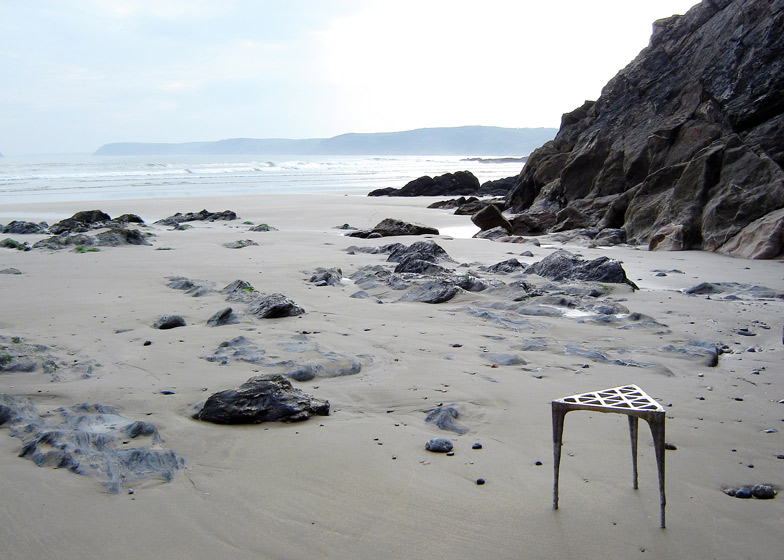The next extract chosen by Dezeen editor-in-chief Marcus Fairs from our Book of Ideas is a pewter stool cast in sand on a Cornish beach.
"If you search for Max Lamb's Pewter Stool on Google Images you don't find the studio-quality product shots you might expect. Instead you get dozens of photos of a beach in Cornwall. That's where Lamb cast the stool, using the sand as his mould. The beach is a place Lamb remembers from his childhood and the material and casting method were once a proud local industry," says Fairs.
"The making of the stool and the narrative behind it are what makes this product special and it could be argued that the evocative time-lapse movie Lamb filmed of the casting performance (and uploaded to YouTube) is a more robust cultural artefact than the stool itself."
"For me this product represents the way the ease with which projects can be digitally documented plus the distributive power of the internet is changing the way designers work, and the way their work is perceived," he adds.
Pewter Stool by Max Lamb
Rebuffed by sand-casting foundries that laughed at his request to produce a single stool, British designer Max Lamb instead decided to make it himself.
Lamb returned to a favourite childhood beach in Cornwall and sculpted the mould for his stool directly into the wet sand.
The furniture designer melted pewter – a malleable alloy consisting mainly of tin with small amounts of copper and other metals – in a saucepan placed on a camping stove and poured the liquid metal into the mould. Once it had cooled, he dug away the sand to reveal the finished product.
Despite being a comparatively simple object, Pewter Stool is rich in narrative. Tin mining was once the main industry in Cornwall and sand from local beaches was used in the casting foundries. The mould can only be used once, making each piece unique, and the unpredictabil- ity of working on a beach means that imperfections become an inevitable part of each object’s charm.
The manufacturing process is imprecise and labour-intensive, yet practical considerations have driven the stool’s design. The three-legged form ensures that it will not wobble even if, as often happens, the molten metal fails to flow to the bottom of the sand mould. The seat is a grid of tessellating triangles and allows the maximum sitting area from the minimum amount of pewter.
The stool is inseparable from the seaside performance that created it. Lamb produced a time-lapse movie of it being made. While the finished object has become a collectable rarity, the video documentary, disseminated on YouTube and Vimeo, is available to everyone.
Read more about this project on Dezeen | Buy Dezeen Book of Ideas
Reviews of Dezeen Book of Ideas
“From flip-flop art to a mirrored retreat in the sky” – Wall Street Journal
“The Sliding House and The Book of Ideas: Radical Thinking Required” – Forbes.com
“Fairs personally guides readers through the wonders of innovations like a balancing barn, a textile-skinned car, and the first aesthetically pleasing CFL — all of which share an ‘I wish I’d thought of that’ awe factor” – Sight Unseen
“Fabulous” – It’s Nice That
“Totally wonderful!” – Naomi Cleaver
“Handsomely repackages Dezeen’s coverage of the best in architectural, interior and design ideas” – Glasgow Herald
“Teeming with innovative projects handpicked by the people behind Dezeen … readers will be hard-pressed not to find something to gawk over in this intriguing new compendium of beautifully articulated concepts” – Dwell Asia
“Beautifully laid-out, to suit the content, and straight-shooting, non-convoluted descriptions make it user-friendly as well as eye-catching” – Lifestyle Magazine

